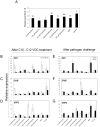Induced resistance by a long-chain bacterial volatile: elicitation of plant systemic defense by a C13 volatile produced by Paenibacillus polymyxa
- PMID: 23209558
- PMCID: PMC3509098
- DOI: 10.1371/journal.pone.0048744
Induced resistance by a long-chain bacterial volatile: elicitation of plant systemic defense by a C13 volatile produced by Paenibacillus polymyxa
Abstract
Background: Some strains of plant growth-promoting rhizobacteria (PGPR) elicit induced systemic resistance (ISR) by emission of volatile organic compounds (VOCs) including short chain alcohols, acetoin, and 2,3-butanediol. The objective of this study was to evaluate whether species-specific VOCs from PGPR strain Paenibacillus polymyxa E681 can promote growth and induce resistance in Arabidopsis.
Methodology/principal findings: The efficacy of induction was strain-specific, with stronger protection against Pseudomonas syringae pv. maculicola ES4326 in plants exposed to VOCs from P. polymyxa E681 versus Arabidopsis plants exposed to VOCs from a reference strain Bacillus subtilis GB03, which was previously shown to elicit ISR and plant growth promotion. VOC emissions released from E681 primed transcriptional expression of the salicylic acid, jasmonic acid, and ethylene signaling marker genes PR1, ChiB, and VSP2, respectively. In addition, strain E681 produced more than thirty low molecular-weight VOCs, of which tridecane was only produced by E681 and not found in GB03 or IN937a volatile blends. These strain-specific VOCs induced PR1 and VSP2 genes.
Conclusions/significance: These results provide new insight into the existence of a long chain VOC signaling molecule produced by P. polymyxa that can serve as a bacterial trigger of induced systemic resistance in planta.
Conflict of interest statement
Figures




Similar articles
-
One shot-two pathogens blocked: exposure of Arabidopsis to hexadecane, a long chain volatile organic compound, confers induced resistance against both Pectobacterium carotovorum and Pseudomonas syringae.Plant Signal Behav. 2013 Jul;8(7):e24619. doi: 10.4161/psb.24619. Epub 2013 Apr 19. Plant Signal Behav. 2013. PMID: 23603940 Free PMC article.
-
Proteomic analyses of the interaction between the plant-growth promoting rhizobacterium Paenibacillus polymyxa E681 and Arabidopsis thaliana.Proteomics. 2016 Jan;16(1):122-35. doi: 10.1002/pmic.201500196. Proteomics. 2016. PMID: 26460066
-
Bacterial volatiles induce systemic resistance in Arabidopsis.Plant Physiol. 2004 Mar;134(3):1017-26. doi: 10.1104/pp.103.026583. Epub 2004 Feb 19. Plant Physiol. 2004. PMID: 14976231 Free PMC article.
-
Dynamic chemical communication between plants and bacteria through airborne signals: induced resistance by bacterial volatiles.J Chem Ecol. 2013 Jul;39(7):1007-18. doi: 10.1007/s10886-013-0317-9. Epub 2013 Jul 24. J Chem Ecol. 2013. PMID: 23881442 Free PMC article. Review.
-
Microbial volatiles as plant growth inducers.Microbiol Res. 2018 Mar;208:63-75. doi: 10.1016/j.micres.2018.01.002. Epub 2018 Jan 31. Microbiol Res. 2018. PMID: 29551213 Review.
Cited by
-
Endophytic Paenibacillus polymyxa LMG27872 inhibits Meloidogyne incognita parasitism, promoting tomato growth through a dose-dependent effect.Front Plant Sci. 2022 Sep 14;13:961085. doi: 10.3389/fpls.2022.961085. eCollection 2022. Front Plant Sci. 2022. PMID: 36186028 Free PMC article.
-
Suppressive potential of Paenibacillus strains isolated from the tomato phyllosphere against fusarium crown and root rot of tomato.Microbes Environ. 2014;29(2):168-77. doi: 10.1264/jsme2.me13172. Epub 2014 Jun 10. Microbes Environ. 2014. PMID: 24920171 Free PMC article.
-
Bacillus volatiles adversely affect the physiology and ultra-structure of Ralstonia solanacearum and induce systemic resistance in tobacco against bacterial wilt.Sci Rep. 2017 Jan 16;7:40481. doi: 10.1038/srep40481. Sci Rep. 2017. PMID: 28091587 Free PMC article.
-
Volatile-Mediated Effects Predominate in Paraburkholderia phytofirmans Growth Promotion and Salt Stress Tolerance of Arabidopsis thaliana.Front Microbiol. 2016 Nov 17;7:1838. doi: 10.3389/fmicb.2016.01838. eCollection 2016. Front Microbiol. 2016. PMID: 27909432 Free PMC article.
-
Antibiotic potential and metabolic modulation of Bacillus velezensis VTRNT 01 in response to bacterial elicitors.World J Microbiol Biotechnol. 2025 Mar 12;41(3):102. doi: 10.1007/s11274-025-04311-z. World J Microbiol Biotechnol. 2025. PMID: 40069525
References
-
- Kloepper J, Metting F Jr. (1992) Plant growth-promoting rhizobacteria as biological control agents. Soil microbial ecology: applications in agricultural and environmental management: 255–274.
-
- Ryu CM, Murphy JF, Mysore KS, Kloepper JW (2004) Plant growth-promoting rhizobacteria systemically protect Arabidopsis thaliana against Cucumber mosaic virus by a salicylic acid and NPR1-independent and jasmonic acid-dependent signaling pathway. Plant J 39: 381–392. - PubMed
-
- Ryu CM, Kim J, Choi O, Kim SH, Park CS (2006) Improvement of biological control capacity of Paenibacillus polymyxa E681 by seed pelleting on sesame. Biol Control 39: 282–289.
-
- Van Loon L, Bakker P, Pieterse C (1998) Systemic resistance induced by rhizosphere bacteria. Annu Rev Phytopathol 36: 453–483. - PubMed
-
- Kloepper JW, Ryu CM, Zhang S (2004) Induced systemic resistance and promotion of plant growth by Bacillus spp. Phytopathology 94: 1259–1266. - PubMed
Publication types
MeSH terms
Substances
LinkOut - more resources
Full Text Sources
Other Literature Sources

